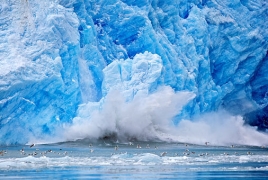
A spate of extreme warmth in the Arctic over the past two months has startled scientists, who warn that the high temperatures may lead to record-low ice coverage next summer and even more warming in a region that is already among the hardest hit by climate change, The New York Times reports.
In mid-November, parts of the Arctic were more than 35 degrees Fahrenheit warmer than observed averages, scientists said, and at the pole itself, mean temperatures for the month were 23 degrees above normal. Although conditions later cooled somewhat, the extreme warmth is expected to return, with temperatures forecast to be as much as 27 degrees above normal beginning Thursday, December 22.
Jeremy Mathis, who directs the Arctic Research Program for the National Oceanic and Atmospheric Administration said the warmth had led to a later than usual “freeze-up” of ice in the Arctic Ocean. That in turn may lead to record-low ice coverage in the spring and summer, which could lead to more warming because there will be less ice to reflect the sun’s rays and more darker, exposed ocean to absorb them.
“We’re going to be watching the summer of 2017 very closely,” Dr. Mathis said in an interview.
On Wednesday, researchers released a study linking the abnormally high Arctic temperatures to human-caused climate change. Using simulations of the climate, both current and before widespread carbon emissions, they found that the likelihood of extreme temperatures like those that occurred this fall had increased to about once every 50 years from about once every 1,000 years.
“A warm episode like the one we are currently observing is still a rare event in today’s climate,” said one of the researchers, Friederike E.L. Otto, a senior scientist at the Environmental Change Institute at the University of Oxford in Britain. “But it would have been an extremely unlikely event without anthropogenic climate change.”
What’s more, Dr. Otto said, if climate change continues at its current pace, spates of extreme Arctic warmth may become common, on the order of once every two years.
“It’s quite impressive how much the risk of these kinds of events is changing,” she said. “It’s one region where we see the impacts of climate change very strongly.”
Walt Meier, a research scientist at NASA’s Goddard Space Flight Center, said that the current warmth had been brought on by fluctuations in the jet stream, which have allowed frigid air to make its way south into North America and warm air into parts of the Arctic.
While such outbreaks of extreme warmth are not new, he said, there are many signs that climate change is making them more frequent. “We’re loading the dice to make this more likely,” he said.

